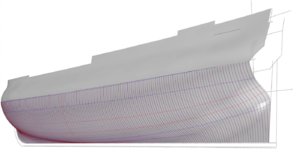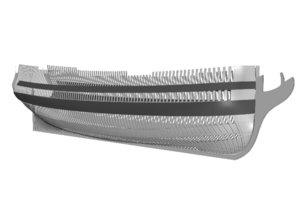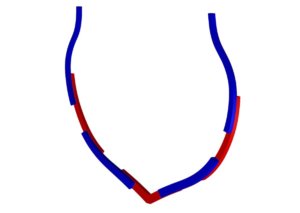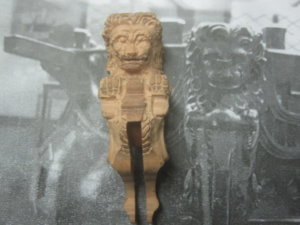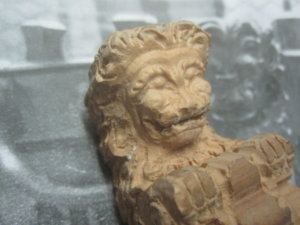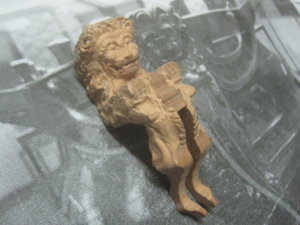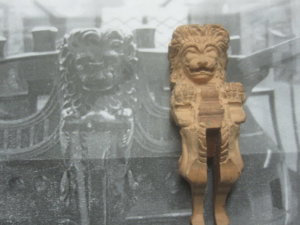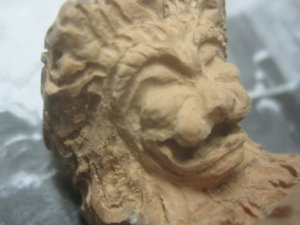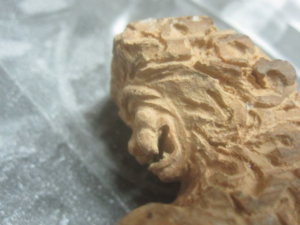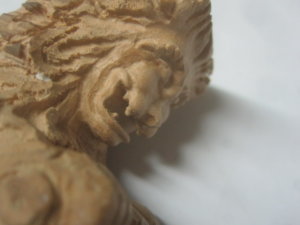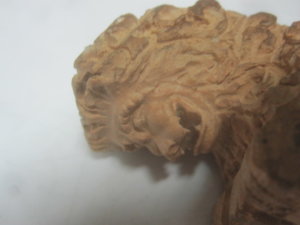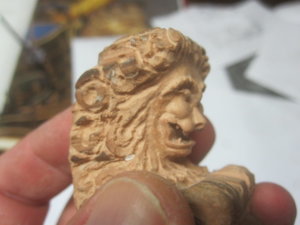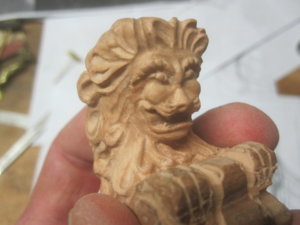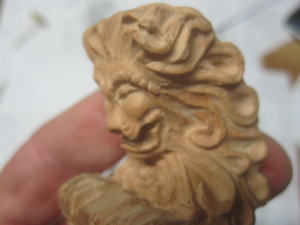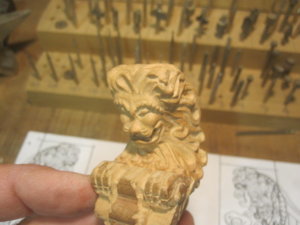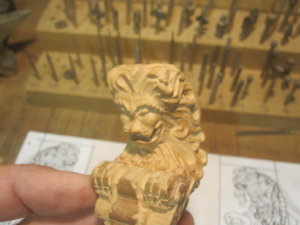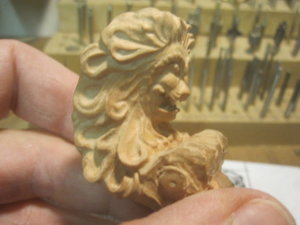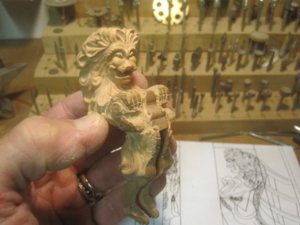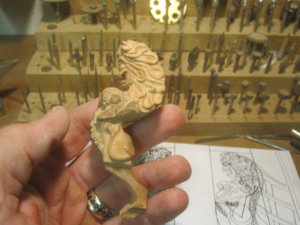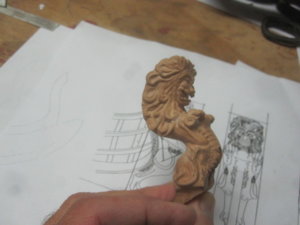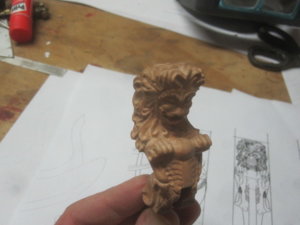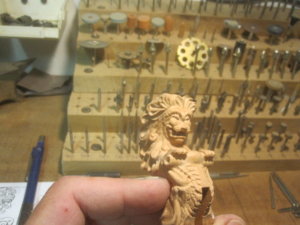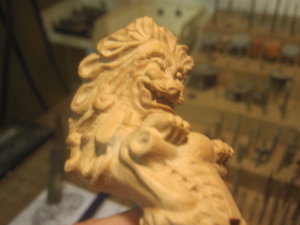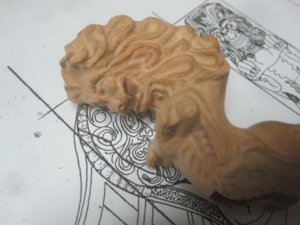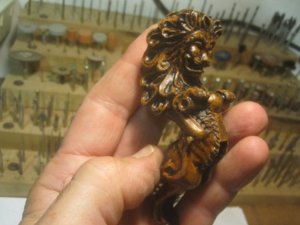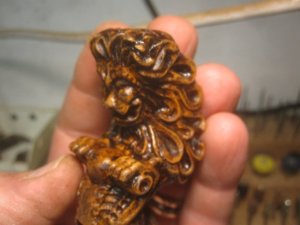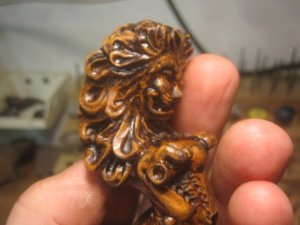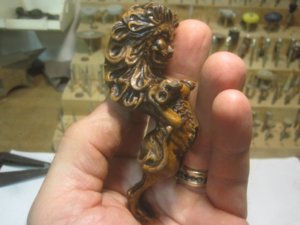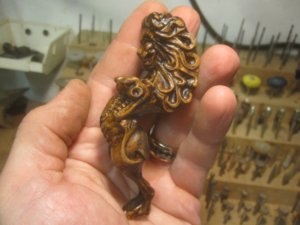- Joined
- Sep 28, 2018
- Messages
- 250
- Points
- 373

Buonasera, inizio un nuovo cantiere, per ora solo la polena in quanto i piani sono ancora in fase di sviluppo. Si tratta di un 74 cannoni veneziano appartenete alla collezione del museo di Venezia da cui il mio
Good evening, start a new construction site, for now only the figurehead as the plans are still under development. It is a 74 Venetian guns belonging to the collection of the Venice museum from which mine

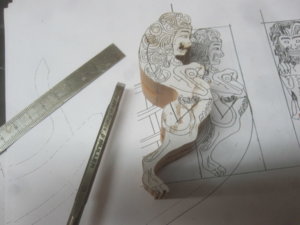
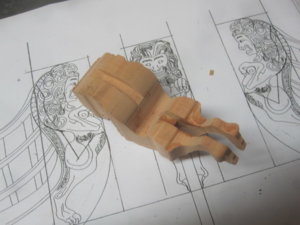
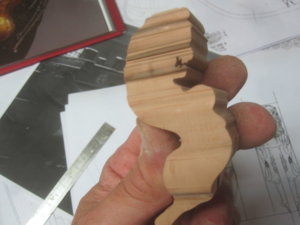
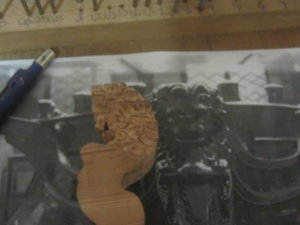
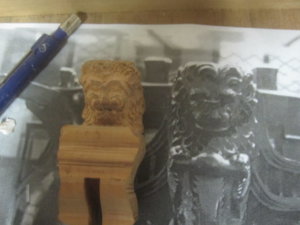
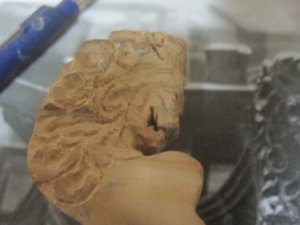
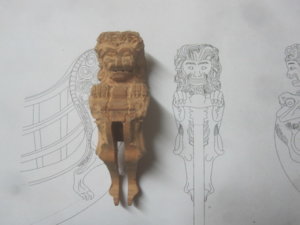
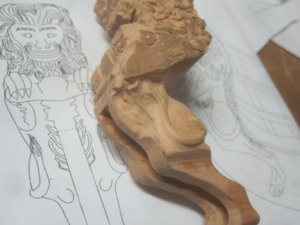 amico ingegnere Luigi Ombrato ha fatto la fotogrammetria per poi ricavarne i piani.
amico ingegnere Luigi Ombrato ha fatto la fotogrammetria per poi ricavarne i piani.
VASCELLO VENEZIANO CLASSE 1780 scala 1/44
Il modello che verrà costruito sarà parte integrante dello studio sulla Marineria veneziana che si sta cercando di analizzare. Lo studio è partito esaminato tramite i rilievi due modelli appartenenti alla collezione del Museo della Marina Militare di Venezia; 1780. La scala del modello esaminata è 1:22, confrontata con i disegni della classe 1780 custoditi presso l'Archivio di Trieste, la scala della tavola della classe 1780 è di 1:44, il doppio del modello in questione. La scala particolare, non dodicesimale esatta, è una stranezza, ma non una rarità, molti modelli italiani, e spagnoli spesso non utilizzati scala dodicesimali esatte, utilizzati usando scala frazionata. Le scale frazionate principalmente utilizzate sono la 1: 32 e la 1:44, in particolare la seconda è una scala denominata: un piede a pollice frazionato a 3 + 2/3, ciò determina quindi come traduzioni delle misure che ogni piede o pollice delle misure reali della nave, frazionato su 1 / 12 risulterà creato collegati come un piede o una linea; tale misura andrà poi frazionata per (3 + 2/3) valori compatibili con una scala dodicesimale. La scala 1:22 (undicesimale) dei modelli non è giustificabile se non partendo dalla scala 1:44 che è una scala frazionata. Quindi è necessario vedere la scala come una scala derivata dalla 1:44 moltiplicando per due le misure da disegno, e non come una scala assestante. Il discorso appena fatto, apparentemente superfluo, in realtà è molto importante poichè da esso dipende ogni misura di cantiere. un piede a pollice frazionato a 3 + 2/3, ciò determina quindi come traduzioni delle misure che ogni piede o pollice delle misure reali della navata, frazionato su 1/12 risulterà collegato a come un piede o una linea; tale misura andrà poi frazionata per (3 + 2/3) valori compatibili con una scala dodicesimale. La scala 1:22 (undicesimale) dei modelli non è giustificabile se non partendo dalla scala 1:44 che è una scala frazionata. Quindi è necessario vedere la scala come una scala derivata dalla 1:44 moltiplicando per due le misure da disegno, e non come una scala assestante. Il discorso appena fatto, apparentemente superfluo, in realtà è molto importante poichè da esso dipende ogni misura di cantiere. un piede a pollice frazionato a 3 + 2/3, ciò determina quindi come traduzioni delle misure che ogni piede o pollice delle misure reali della navata, frazionato su 1/12 risulterà collegato a come un piede o una linea; tale misura andrà poi frazionata per (3 + 2/3) valori compatibili con una scala dodicesimale. La scala 1:22 (undicesimale) dei modelli non è giustificabile se non partendo dalla scala 1:44 che è una scala frazionata. Quindi è necessario vedere la scala come una scala derivata dalla 1:44 moltiplicando per due le misure da disegno, e non come una scala assestante. Il discorso appena fatto, apparentemente superfluo, in realtà è molto importante poichè da esso dipende ogni misura di cantiere. frazionato su 1/12 risulterà assegnato quelli come un piede o una linea; tale misura andrà poi frazionata per (3 + 2/3) valori compatibili con una scala dodicesimale. La scala 1:22 (undicesimale) dei modelli non è giustificabile se non partendo dalla scala 1:44 che è una scala frazionata. Quindi è necessario vedere la scala come una scala derivata dalla 1:44 moltiplicando per due le misure da disegno, e non come una scala assestante. Il discorso appena fatto, apparentemente superfluo, in realtà è molto importante poichè da esso dipende ogni misura di cantiere. frazionato su 1/12 risulterà assegnato quelli come un piede o una linea; tale misura andrà poi frazionata per (3 + 2/3) valori compatibili con una scala dodicesimale. La scala 1:22 (undicesimale) dei modelli non è giustificabile se non partendo dalla scala 1:44 che è una scala frazionata. Quindi è necessario vedere la scala come una scala derivata dalla 1:44 moltiplicando per due le misure da disegno, e non come una scala assestante. Il discorso appena fatto, apparentemente superfluo, in realtà è molto importante poichè da esso dipende ogni misura di cantiere. 44 che è una scala frazionata. Quindi è necessario vedere la scala come una scala derivata dalla 1:44 moltiplicando per due le misure da disegno, e non come una scala assestante. Il discorso appena fatto, apparentemente superfluo, in realtà è molto importante poichè da esso dipende ogni misura di cantiere. 44 che è una scala frazionata. Quindi è necessario vedere la scala come una scala derivata dalla 1:44 moltiplicando per due le misure da disegno, e non come una scala assestante. Il discorso appena fatto, apparentemente superfluo, in realtà è molto importante poichè da esso dipende ogni misura di cantiere.
Ing. Luigi Ombrato
VENETIAN CLASS E 1780 scale 1/44 scale
The model that will be built will be an integral part of the study on the Venetian Marine that you are trying to analyze. The study began with the examination of two models belonging to the collection of the Museum of the Navy of Venice; 1780. The scale of the model examined is 1:22, compared with the drawings of the 1780 class kept in the Trieste Archive, the scale of the 1780 class table is 1:44, twice the model in question. The particular scale, not exact twelfth, is an oddity, but not a rarity, many Italian models, and Spanish often not used exact twelfths scale, used using fractional scale. The fractioned scales mainly used are the 1: 32 and the 1:44, in particular the second is a scale called: a foot with a fractionated inch at 3 + 2/3, this determines therefore as translations of the measurements that every foot or inch of the actual measurements of the ship, fractionated on 1/12 will be created connected as a foot or a line; this measurement must then be fractionated by (3 + 2/3) values compatible with a twelve-point scale. The 1:22 scale (eleventh) of the models is not justifiable if not starting from the 1:44 scale which is a fractional scale. Therefore it is necessary to see the scale as a scale derived from 1:44 by multiplying the drawing measurements by two, and not as an adjustment scale. The seemingly superfluous discourse just made is actually very important because every yardstick measure depends on it. a foot with a fractional inch at 3 + 2/3, this then determines as translations of the measurements that every foot or inch of the actual dimensions of the nave, divided on 1/12, will be connected to a foot or a line; this measurement must then be fractionated by (3 + 2/3) values compatible with a twelve-point scale. The 1:22 scale (eleventh) of the models is not justifiable if not starting from the 1:44 scale which is a fractional scale. Therefore it is necessary to see the scale as a scale derived from 1:44 by multiplying the drawing measurements by two, and not as an adjustment scale. The seemingly superfluous discourse just made is actually very important because every yardstick measure depends on it. a foot with a fractional inch at 3 + 2/3, this then determines as translations of the measurements that every foot or inch of the actual dimensions of the nave, divided on 1/12, will be connected to a foot or a line; this measurement must then be fractionated by (3 + 2/3) values compatible with a twelve-point scale. The 1:22 scale (eleventh) of the models is not justifiable if not starting from the 1:44 scale which is a fractional scale. Therefore it is necessary to see the scale as a scale derived from 1:44 by multiplying the drawing measurements by two, and not as an adjustment scale. The seemingly superfluous discourse just made is actually very important because every yardstick measure depends on it. fractionated on 1/12 it will be assigned those like a foot or a line; this measurement must then be fractionated by (3 + 2/3) values compatible with a twelve-point scale. The 1:22 scale (eleventh) of the models is not justifiable if not starting from the 1:44 scale which is a fractional scale. Therefore it is necessary to see the scale as a scale derived from 1:44 by multiplying the drawing measurements by two, and not as an adjustment scale. The seemingly superfluous discourse just made is actually very important because every yardstick measure depends on it. fractionated on 1/12 it will be assigned those like a foot or a line; this measurement must then be fractionated by (3 + 2/3) values compatible with a twelve-point scale. The 1:22 scale (eleventh) of the models is not justifiable if not starting from the 1:44 scale which is a fractional scale. Therefore it is necessary to see the scale as a scale derived from 1:44 by multiplying the drawing measurements by two, and not as an adjustment scale. The seemingly superfluous discourse just made is actually very important because every yardstick measure depends on it. 44 which is a fractional scale. Therefore it is necessary to see the scale as a scale derived from 1:44 by multiplying the drawing measurements by two, and not as an adjustment scale. The seemingly superfluous discourse just made is actually very important because every yardstick measure depends on it. 44 which is a fractional scale. Therefore it is necessary to see the scale as a scale derived from 1:44 by multiplying the drawing measurements by two, and not as an adjustment scale. The seemingly superfluous discourse just made is actually very important because every yardstick measure depends on it.
Ing. Luigi Ombrato
Good evening, start a new construction site, for now only the figurehead as the plans are still under development. It is a 74 Venetian guns belonging to the collection of the Venice museum from which mine








 amico ingegnere Luigi Ombrato ha fatto la fotogrammetria per poi ricavarne i piani.
amico ingegnere Luigi Ombrato ha fatto la fotogrammetria per poi ricavarne i piani.VASCELLO VENEZIANO CLASSE 1780 scala 1/44
Il modello che verrà costruito sarà parte integrante dello studio sulla Marineria veneziana che si sta cercando di analizzare. Lo studio è partito esaminato tramite i rilievi due modelli appartenenti alla collezione del Museo della Marina Militare di Venezia; 1780. La scala del modello esaminata è 1:22, confrontata con i disegni della classe 1780 custoditi presso l'Archivio di Trieste, la scala della tavola della classe 1780 è di 1:44, il doppio del modello in questione. La scala particolare, non dodicesimale esatta, è una stranezza, ma non una rarità, molti modelli italiani, e spagnoli spesso non utilizzati scala dodicesimali esatte, utilizzati usando scala frazionata. Le scale frazionate principalmente utilizzate sono la 1: 32 e la 1:44, in particolare la seconda è una scala denominata: un piede a pollice frazionato a 3 + 2/3, ciò determina quindi come traduzioni delle misure che ogni piede o pollice delle misure reali della nave, frazionato su 1 / 12 risulterà creato collegati come un piede o una linea; tale misura andrà poi frazionata per (3 + 2/3) valori compatibili con una scala dodicesimale. La scala 1:22 (undicesimale) dei modelli non è giustificabile se non partendo dalla scala 1:44 che è una scala frazionata. Quindi è necessario vedere la scala come una scala derivata dalla 1:44 moltiplicando per due le misure da disegno, e non come una scala assestante. Il discorso appena fatto, apparentemente superfluo, in realtà è molto importante poichè da esso dipende ogni misura di cantiere. un piede a pollice frazionato a 3 + 2/3, ciò determina quindi come traduzioni delle misure che ogni piede o pollice delle misure reali della navata, frazionato su 1/12 risulterà collegato a come un piede o una linea; tale misura andrà poi frazionata per (3 + 2/3) valori compatibili con una scala dodicesimale. La scala 1:22 (undicesimale) dei modelli non è giustificabile se non partendo dalla scala 1:44 che è una scala frazionata. Quindi è necessario vedere la scala come una scala derivata dalla 1:44 moltiplicando per due le misure da disegno, e non come una scala assestante. Il discorso appena fatto, apparentemente superfluo, in realtà è molto importante poichè da esso dipende ogni misura di cantiere. un piede a pollice frazionato a 3 + 2/3, ciò determina quindi come traduzioni delle misure che ogni piede o pollice delle misure reali della navata, frazionato su 1/12 risulterà collegato a come un piede o una linea; tale misura andrà poi frazionata per (3 + 2/3) valori compatibili con una scala dodicesimale. La scala 1:22 (undicesimale) dei modelli non è giustificabile se non partendo dalla scala 1:44 che è una scala frazionata. Quindi è necessario vedere la scala come una scala derivata dalla 1:44 moltiplicando per due le misure da disegno, e non come una scala assestante. Il discorso appena fatto, apparentemente superfluo, in realtà è molto importante poichè da esso dipende ogni misura di cantiere. frazionato su 1/12 risulterà assegnato quelli come un piede o una linea; tale misura andrà poi frazionata per (3 + 2/3) valori compatibili con una scala dodicesimale. La scala 1:22 (undicesimale) dei modelli non è giustificabile se non partendo dalla scala 1:44 che è una scala frazionata. Quindi è necessario vedere la scala come una scala derivata dalla 1:44 moltiplicando per due le misure da disegno, e non come una scala assestante. Il discorso appena fatto, apparentemente superfluo, in realtà è molto importante poichè da esso dipende ogni misura di cantiere. frazionato su 1/12 risulterà assegnato quelli come un piede o una linea; tale misura andrà poi frazionata per (3 + 2/3) valori compatibili con una scala dodicesimale. La scala 1:22 (undicesimale) dei modelli non è giustificabile se non partendo dalla scala 1:44 che è una scala frazionata. Quindi è necessario vedere la scala come una scala derivata dalla 1:44 moltiplicando per due le misure da disegno, e non come una scala assestante. Il discorso appena fatto, apparentemente superfluo, in realtà è molto importante poichè da esso dipende ogni misura di cantiere. 44 che è una scala frazionata. Quindi è necessario vedere la scala come una scala derivata dalla 1:44 moltiplicando per due le misure da disegno, e non come una scala assestante. Il discorso appena fatto, apparentemente superfluo, in realtà è molto importante poichè da esso dipende ogni misura di cantiere. 44 che è una scala frazionata. Quindi è necessario vedere la scala come una scala derivata dalla 1:44 moltiplicando per due le misure da disegno, e non come una scala assestante. Il discorso appena fatto, apparentemente superfluo, in realtà è molto importante poichè da esso dipende ogni misura di cantiere.
Ing. Luigi Ombrato
VENETIAN CLASS E 1780 scale 1/44 scale
The model that will be built will be an integral part of the study on the Venetian Marine that you are trying to analyze. The study began with the examination of two models belonging to the collection of the Museum of the Navy of Venice; 1780. The scale of the model examined is 1:22, compared with the drawings of the 1780 class kept in the Trieste Archive, the scale of the 1780 class table is 1:44, twice the model in question. The particular scale, not exact twelfth, is an oddity, but not a rarity, many Italian models, and Spanish often not used exact twelfths scale, used using fractional scale. The fractioned scales mainly used are the 1: 32 and the 1:44, in particular the second is a scale called: a foot with a fractionated inch at 3 + 2/3, this determines therefore as translations of the measurements that every foot or inch of the actual measurements of the ship, fractionated on 1/12 will be created connected as a foot or a line; this measurement must then be fractionated by (3 + 2/3) values compatible with a twelve-point scale. The 1:22 scale (eleventh) of the models is not justifiable if not starting from the 1:44 scale which is a fractional scale. Therefore it is necessary to see the scale as a scale derived from 1:44 by multiplying the drawing measurements by two, and not as an adjustment scale. The seemingly superfluous discourse just made is actually very important because every yardstick measure depends on it. a foot with a fractional inch at 3 + 2/3, this then determines as translations of the measurements that every foot or inch of the actual dimensions of the nave, divided on 1/12, will be connected to a foot or a line; this measurement must then be fractionated by (3 + 2/3) values compatible with a twelve-point scale. The 1:22 scale (eleventh) of the models is not justifiable if not starting from the 1:44 scale which is a fractional scale. Therefore it is necessary to see the scale as a scale derived from 1:44 by multiplying the drawing measurements by two, and not as an adjustment scale. The seemingly superfluous discourse just made is actually very important because every yardstick measure depends on it. a foot with a fractional inch at 3 + 2/3, this then determines as translations of the measurements that every foot or inch of the actual dimensions of the nave, divided on 1/12, will be connected to a foot or a line; this measurement must then be fractionated by (3 + 2/3) values compatible with a twelve-point scale. The 1:22 scale (eleventh) of the models is not justifiable if not starting from the 1:44 scale which is a fractional scale. Therefore it is necessary to see the scale as a scale derived from 1:44 by multiplying the drawing measurements by two, and not as an adjustment scale. The seemingly superfluous discourse just made is actually very important because every yardstick measure depends on it. fractionated on 1/12 it will be assigned those like a foot or a line; this measurement must then be fractionated by (3 + 2/3) values compatible with a twelve-point scale. The 1:22 scale (eleventh) of the models is not justifiable if not starting from the 1:44 scale which is a fractional scale. Therefore it is necessary to see the scale as a scale derived from 1:44 by multiplying the drawing measurements by two, and not as an adjustment scale. The seemingly superfluous discourse just made is actually very important because every yardstick measure depends on it. fractionated on 1/12 it will be assigned those like a foot or a line; this measurement must then be fractionated by (3 + 2/3) values compatible with a twelve-point scale. The 1:22 scale (eleventh) of the models is not justifiable if not starting from the 1:44 scale which is a fractional scale. Therefore it is necessary to see the scale as a scale derived from 1:44 by multiplying the drawing measurements by two, and not as an adjustment scale. The seemingly superfluous discourse just made is actually very important because every yardstick measure depends on it. 44 which is a fractional scale. Therefore it is necessary to see the scale as a scale derived from 1:44 by multiplying the drawing measurements by two, and not as an adjustment scale. The seemingly superfluous discourse just made is actually very important because every yardstick measure depends on it. 44 which is a fractional scale. Therefore it is necessary to see the scale as a scale derived from 1:44 by multiplying the drawing measurements by two, and not as an adjustment scale. The seemingly superfluous discourse just made is actually very important because every yardstick measure depends on it.
Ing. Luigi Ombrato
Last edited by a moderator:





